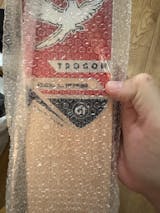To be honest - I got it in the neck from the wife on buying a bat at this price for a 9 year old who’s about to start hardball…. But the grief was worth it. Kashmir bats are taking over and heavy, unresponsive, not good for juniors inho and when branded actually expensive. The difference in the willow is immediately evident. Not only from the weight. The ping is evident. As soon as he hits it right, even brushing it, the ball flies. Given time of year we had a few outside practice sessions and can’t wait for him to use it next summer. The mid sweet spot keeps the bat moving quicker. He’s rapid. I’m sold. Done. I will keep coming back every next size. The actual cost when factoring the G1 willow is actually a bargain and hand made. Already I’ve seen my son just treat the bat with pride. Packing it away carefully vs throwing it a bag / in given he knows how precious this thing is. Which mentally makes him focus even more - crushing that ball when it comes. 10/10. Wife now has come around seeing him with it and just taking pride in something that’s worth the expense.
Pads fit well and really padded. Can’t wait to try them out at winter nets. Great service and home delivery
It is a beautiful bat. Chosen after consultation with Len, the maker, it lives up to everything he promised, and more. It is slightly heavier than my current bat (which I wanted) yet on pick-up it feels lighter. I haven't had the chance to use it in anger yet, but it feels as if there are many boundaries hidden inside the lovely wood. I couldn't be more delighted with my purchase.
Fantastic service, craftsmanship, and wonderful professional knowledge and advice from Len.... choosing a bat is a very personal thing, and Len was fantastic in making sure I got exactly what I wanted... and at a great price too... highly recommend... in fact I loved it so much I bought another great bat... both are fantastic looking and performing bats...
Fantastic service and professional knowledge and advice from Len.... choosing a bat is a very personal thing, and Len was fantastic in making sure I got exactly what I wanted... and at a great price too... highly recommend...
Fantastic bat. Fantastic craftmanship and fantastic service. My daughter is well impressed and can't wait to use it. Unfortunately , my son has taken a liking to it.... Thank the heavens it's a little too small for him!' I'm busy annoying family and neighbours by knocking it in now....
Outstanding craftmanship / brillian service
Great quality gloves. Super soft palms and straight out the packet can walk to the middle and they mould to your hands. Protection is first class and design is simple and subtle, which is a huge plus for me!
One of the comfiest sets of pads I've ever worn! Quality is superb, protection is elite level and value for money is amazing.
My son loves his new bat and all his friends are asking about Trogon. If you are lucky enough to live nearby then I would encourage you to visit Len and see how the bats are made. My son absolutely loved being taught about the whole process and being able to pick from a vast array that Len has carefully hand crafted himself.
Len was really helpful to tune the bat to the right weight / feel for our daughter’s specific requirements. He took great care and attention to custom build something that she could really use and feel comfortable with. His in-depth knowledge was really valuable.
Really pleased with the bat, the pick up is great and pings nicely off the middle.
Quick and easy order process.
I ordered a new bat for my boy, really impressed with the quality of the willow and speed of delivery
Awesome bat! Great bat and loved everything about it
Picked up this beauty in the winter, ready for pre season as its an absolute gun of a bat! Usually bats take 2/3 years to bed in and find there best, but this was ready from the off and the best bat ive ever bought!
I bought this for my daughter last week and it's changed her game completely!
She's not the strongest girl on the pitch which makes the weight of this bat perfect for her and makes it easy for my her to handle.
Highly recommend this bat for any budding cricketer!
Recently purchased a grade 2 Harrow for my grandson, he is delighted as the pick up is great and at 2lb 2oz is perfect for him. An excellent crafted bat from Trogon cricket. Highly recommend.



